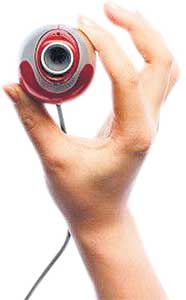
Expanding the digital sphereThe word 'digital' is derived from the Latin word digitus, which means 'finger.' Fingers have always been used as symbols for communication – especially numerical data such as numbers and quantities. So in a sense, humans have always been digital. Later, the notion of a number, as expressed by the finger, was transferred to the written or oral symbol, the number or digit.
The decimal system, or the system based on ten digits, is the one most of us use and are familiar with. From days immemorial, the digits of the hand have been used to create, to innovate, and to communicate. And just as they were used to represent discrete numbers, in recent times, a system of discrete binary digits (limited to the two digits: zero and one) has been developed to which all transmissible data can be reduced. Today, when speaking of 'digital,' we mean machines capable of recording, transmitting, or receiving data in binary digit form. In this context, it is striking that smoke signals and even the Morse and Murray codes relied upon the binary idea (off and on, dot or dash). Digital technologies have been crucial in the distribution of knowledge and information, which many argue are at the core of power in society. Through the use of communication technologies like the internet and the mobile phone, the reach of our relatively short digits has been extended to a much larger sphere – that of the global digital world. Improve your computer literacy Digital TV Digital TV (DTV) has several advantages over analog TV, the most significant being that digital channels take up less bandwidth (and the bandwidth needs are continuously variable, at a corresponding cost in image quality depending on the level of compression). This means that digital broadcasters can provide more digital channels in the same space, provide high-definition television service, or provide other non-television services such as multimedia or interactivity. DTV also permits special services such as multiplexing (more than one program on the same channel), electronic program guides and additional languages, spoken or subtitled. The sale of non-television services may provide an additional revenue source. In many cases, viewers perceive DTV to have superior picture quality, improved audio quality, and easier reception than analog. Bit of byte Blubber buster! It seems like the video games industry, which has always been blamed for causing obesity and inactivity, is now offering players an innovative way to keep fit by combining the skills of a personal trainer and the fun one gets from playing video games. Wii Fit comes at a time when obesity is one of the leading causes of disease globally. Being obese increases your risk of diabetes, heart disease, stroke, arthritis and some cancers. If you are obese, losing even five to 10 percent of your weight, can delay or prevent some of these diseases. It seems like Wii Fit is exactly what many people with these conditions need. Although it may not solve one's weight problems, its developers say it promotes a healthy life style and is an interactive guide to activities that help people keep in shape and have fun at the same time. World on the move An International Telecommunications Union (ITU) report has claimed that just under half the world's population now use mobile phones. Africa showed the strongest gains over the past two years and more than two thirds of all mobile subscribers were from developing countries by the end of 2007, the ITU said. This is "a positive trend that suggests that developing countries are catching up," the report said. More than 3.3 billion people now use mobiles. Subscription growth stood at 39 per cent annually in Africa between 2005 and 2007, and 28 per cent in Asia over the same period. India and China added 154 million and 143 million new subscribers respectively. The global annual average growth rate stood at 22 per cent, the ITU said. Mobile phones are eclipsing traditional fixed lines and in Africa they account for nearly 90 per cent of all telephone subscribers, the report also said. "The continued growth in the mobile sector is matched by no-growth in the fixed-line sector. Fixed telephone penetration has been stagnating at just under 20 per cent globally for the last few years and growth has been below one per cent between 2005 and 2007," it said. While developing countries have made great strides in mobile growth, a significant digital divide remains for internet use and particularly the availability of broadband connections, it noted. High-income countries account for 66 per cent of all fixed broadband subscribers although they only represent 16 per cent of the world's population, while developing countries have just one per cent of fixed broadband users but 38 per cent of the global population. "Low-income countries, where broadband access remains very low, risk falling behind in an area that is particularly important in delivering innovative applications and services," the ITU warned. Some countries have made progress however – the ITU highlighted Chile, Senegal and Turkey as states where almost all internet subscribers have now gone high speed. ~ Courtesy The Australian |
|
||||||
|| Front
Page | News | Editorial | Columns | Sports | Plus | Financial
Times | International | Mirror | TV
Times | Funday
Times || |
| |
Reproduction of articles permitted when used without any alterations to contents and a link to the source page.
|
© Copyright
2008 | Wijeya
Newspapers Ltd.Colombo. Sri Lanka. All Rights Reserved. |
